What Clothes Do Babies Wear the Most? (2025 Guide for New Parents)
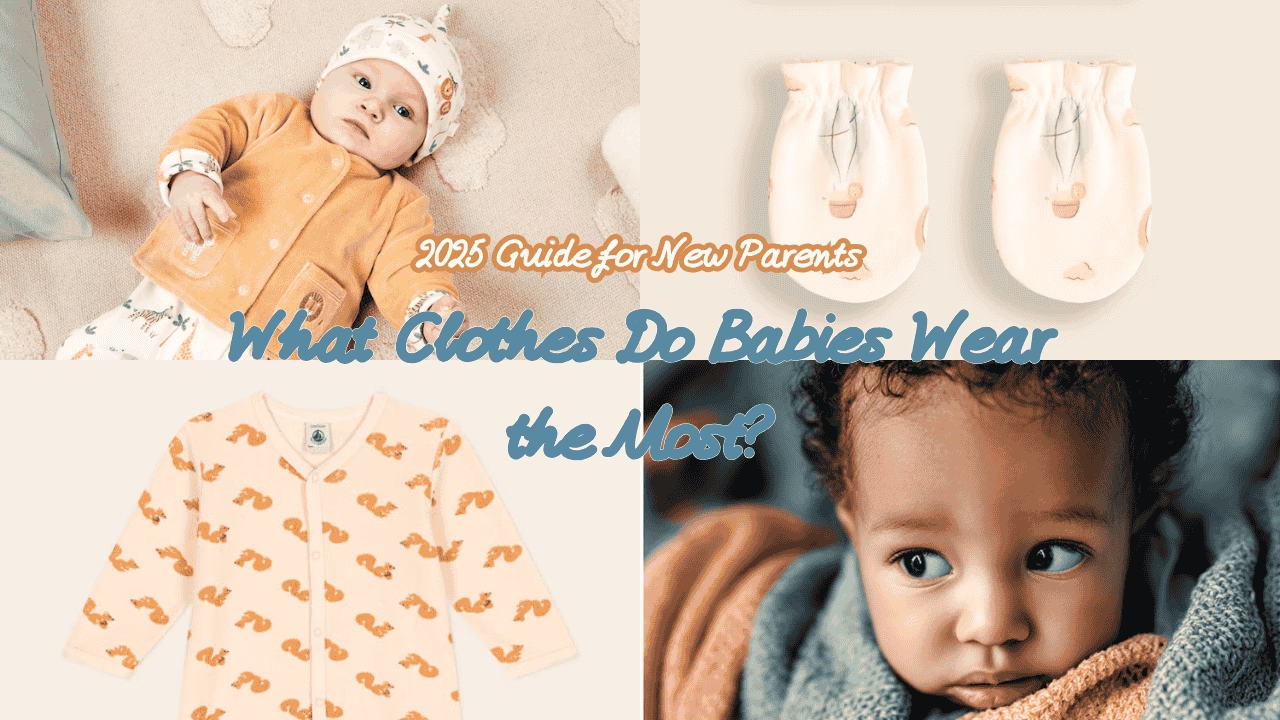
Introduction
“Babies change outfits more than runway models!”
If you’ve ever spent a full day with a newborn, you know that’s not an exaggeration. Between spit-ups, diaper blowouts, drool, and the occasional mysterious stain, your baby might go through five to eight outfit changes in a single day. For a sleep-deprived new parent, the last thing you need is a wardrobe filled with cute but totally useless baby clothes. That’s why understanding what babies actually wear the most is so crucial—it saves you money, time, laundry stress, and closet space.
In this guide, we’ll walk you through the most-used baby clothes for 2025—what you should stock up on, what to skip, and how to build a wardrobe that makes everyday baby care smoother. Whether you’re expecting your first child or just looking to update your essentials for baby number two, we’ve got you covered. Think of this as your no-fluff, real-life baby wardrobe cheat sheet.
Let’s start by breaking down the core wardrobe items your baby will practically live in—trust us, you’ll want multiples!
Must-Have Everyday Baby Clothes
Onesies: The All-Purpose Outfit for Day and Night
If baby wardrobes had a superhero, it would be the humble onesie. These one-piece bodysuits are the MVP of babywear, serving as pajamas, daytime outfits, and even layering pieces. In 2025, you’ll find tons of styles: envelope-neck, kimono-style, and zip-up. Look for ones made from breathable cotton or bamboo—natural materials that feel soft on sensitive baby skin.
Why are onesies so popular? They’re just so easy. Snap closures at the crotch mean quick diaper changes without stripping your baby down entirely. Plus, their snug fit keeps everything in place during all those arm flails and leg kicks. Pro tip: go for onesies with side snaps for newborns to avoid pulling anything over their tiny (and fragile) heads.
You’ll want at least 7-10 onesies in rotation—trust us, between naps, spit-up, and diaper explosions, you’ll run through them quickly.
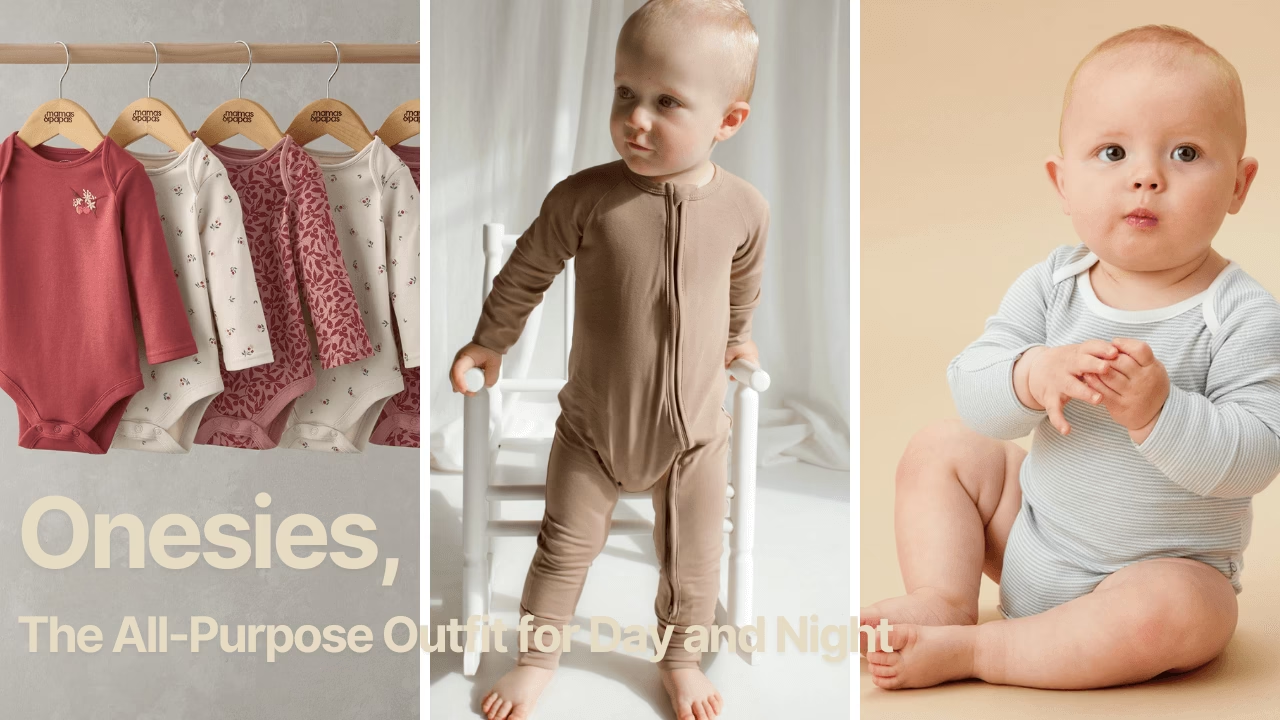
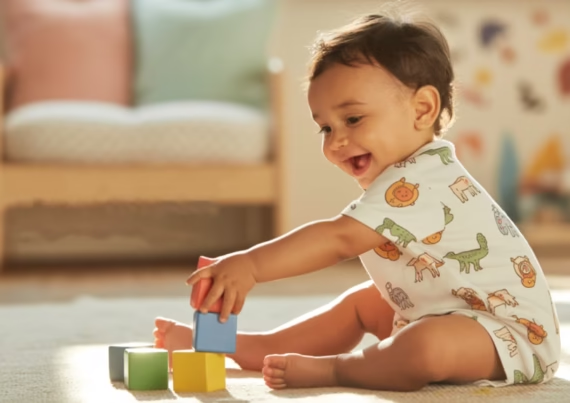
With 17 years of experience, petelulu provides a full range of
manufacturing services from design to delivery.
Start from scratch , Create your own brand.
17+
serving top 10 American brands
15+
serving top 10 Australian brands
12+
serving top 10 European brands
Contact us to get the quote.👇
Footed Pajamas/Sleepers: Warm, Easy-to-Wear, and Great for Sleep
Footed sleepers are another essential you’ll use daily—and nightly. These one-piece pajamas cover baby from neck to toe, often with built-in mittens and feet. In colder months, they help keep your little one warm without needing a loose blanket (which is a no-no in cribs due to safety risks). Look for zip-up sleepers—especially the two-way zip kind that lets you unzip from the bottom during late-night changes.
In 2025, you’ll see trends toward organic cotton and even temperature-regulating fabric options that help keep baby from overheating. Sleepers also reduce the need for socks, which babies are notorious for kicking off.
You’ll need at least 5–8 sleepers. Rotate them frequently and keep a few stashed in your diaper bag for blowout emergencies.
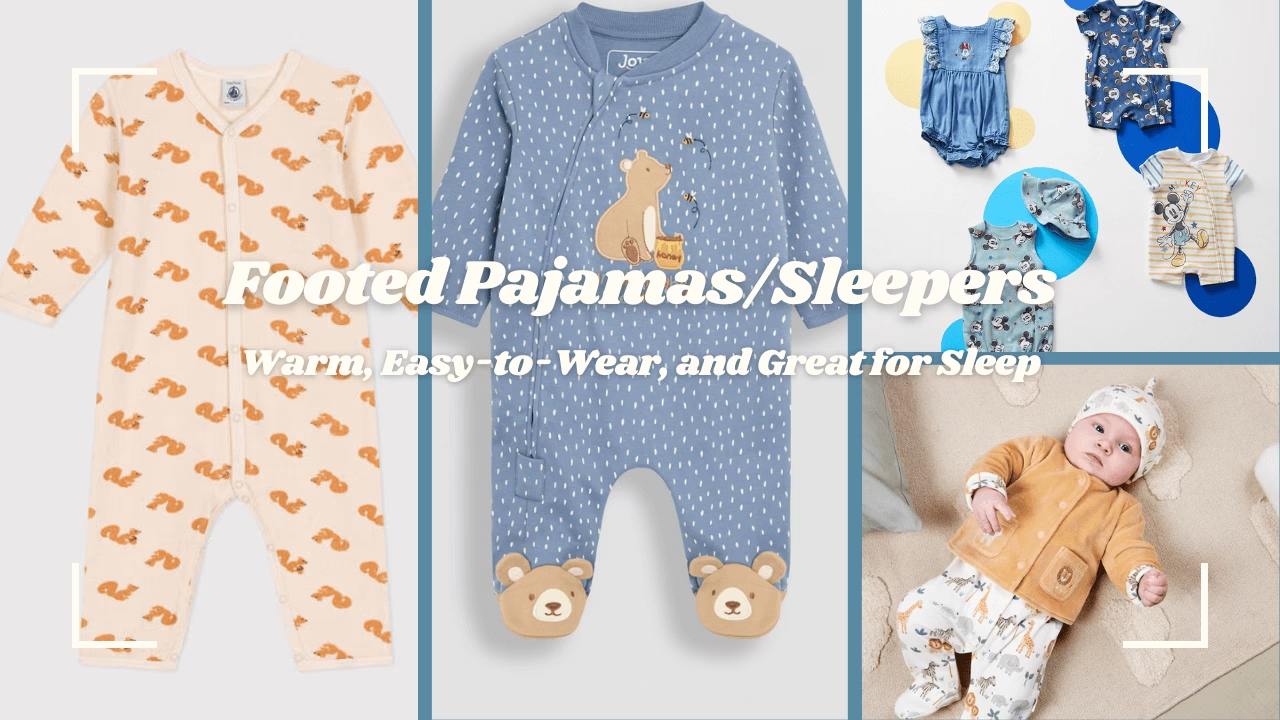
Baby Bodysuits: Layer-Friendly in Short and Long Sleeves
A baby bodysuit is similar to a onesie, but often designed with more layering in mind. These are perfect for fluctuating temperatures—layer them under overalls, sweaters, or rompers depending on the season. They come in both short and long sleeves, which makes them a go-to item for indoor and outdoor wear.
Bodysuits are ideal for mixing and matching outfits. Want to throw on leggings or a skirt over the top? Easy. Need something to keep baby’s belly covered under a romper? Done. You’ll find styles in fun prints, solid colors, and minimalist designs perfect for any vibe you’re going for.
Have at least 6–10 bodysuits handy, mixing short and long sleeves depending on the weather where you live.
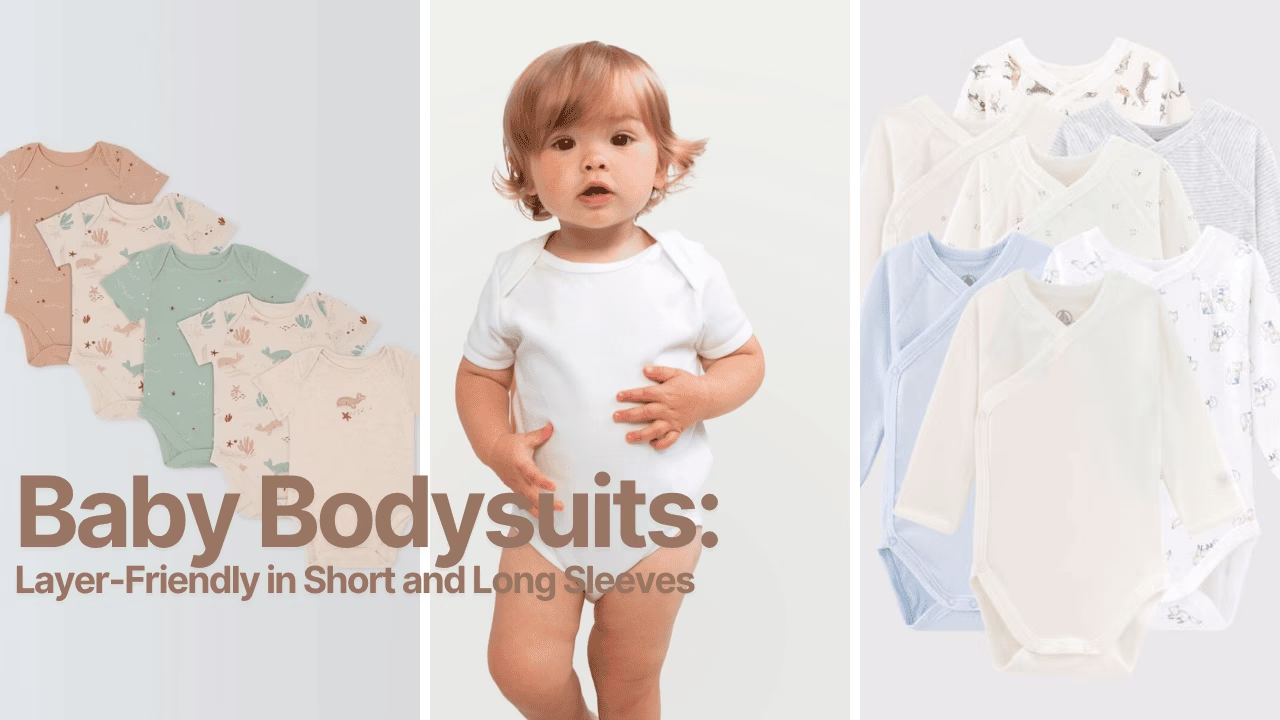
Leggings and Pants with Elastic Waists
Yes, even the tiniest humans need pants! Soft leggings and pants with stretchy waistbands are a parent’s best friend. They’re gentle on baby tummies, easy to pull down for quick diaper changes, and add just enough warmth when it’s chilly.
Avoid jeans or pants with stiff materials—babies spend most of their time lying down, kicking, or curled up in a carrier. Choose leggings made of soft jersey cotton or bamboo blends for ultimate comfort. Bonus points for built-in footies that eliminate the need for socks.
Most parents keep around 5–7 pairs in regular rotation. Stick with gender-neutral colors like gray, navy, and olive so you can mix and match them with all your tops.

Kimono Tops and Side-Snap Shirts
In those early newborn days, kimono-style tops are a game-changer. These wrap-style shirts don’t need to go over the head—something both babies and new parents will be grateful for. Instead, they secure with snaps on the side, keeping the healing umbilical cord area free from irritation.
They’re also great for layering over bodysuits or under swaddles. Many come with built-in mitten cuffs to prevent scratching (newborn nails are sharper than you think!). Look for soft, tag-free designs that won’t rub or irritate baby’s delicate skin.
Keep 4–6 on hand during the newborn stage. They might not last long in terms of size, but they’ll be lifesavers in those first few weeks.
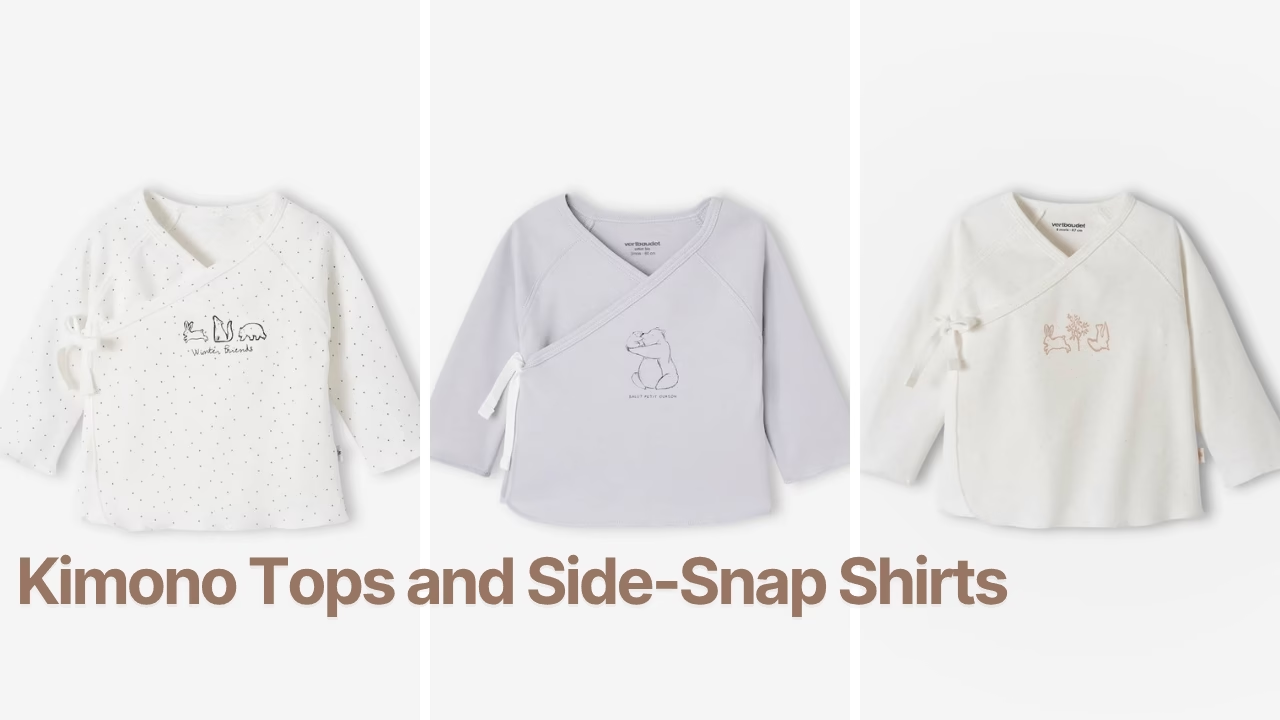
Socks and Mittens: For Warmth and Scratch Prevention
Socks and mittens might seem like minor items, but they play a huge role in keeping your baby cozy and protected. Baby socks, in particular, help regulate body temperature—especially for infants who can’t yet keep themselves warm. While your newborn may not be walking or standing, their little feet still need to be covered, especially in cooler climates or air-conditioned homes.
When it comes to choosing baby socks, the struggle is real: keeping them on. Go for socks with stretchy cuffs that stay put without being too tight. Some 2025 designs even have silicone grips to prevent slippage for those early crawlers.
Mittens, meanwhile, are more than just tiny fashion statements. Newborns have razor-sharp nails and very little control over their hands, so they can easily scratch their faces. Soft cotton mittens protect against accidental scratches while keeping little hands warm. Many newborn tops also come with built-in fold-over mitts—super convenient!
You’ll want at least 5–7 pairs of socks and 3–4 pairs of mittens. Keep extras in your diaper bag and nursery for quick replacements.
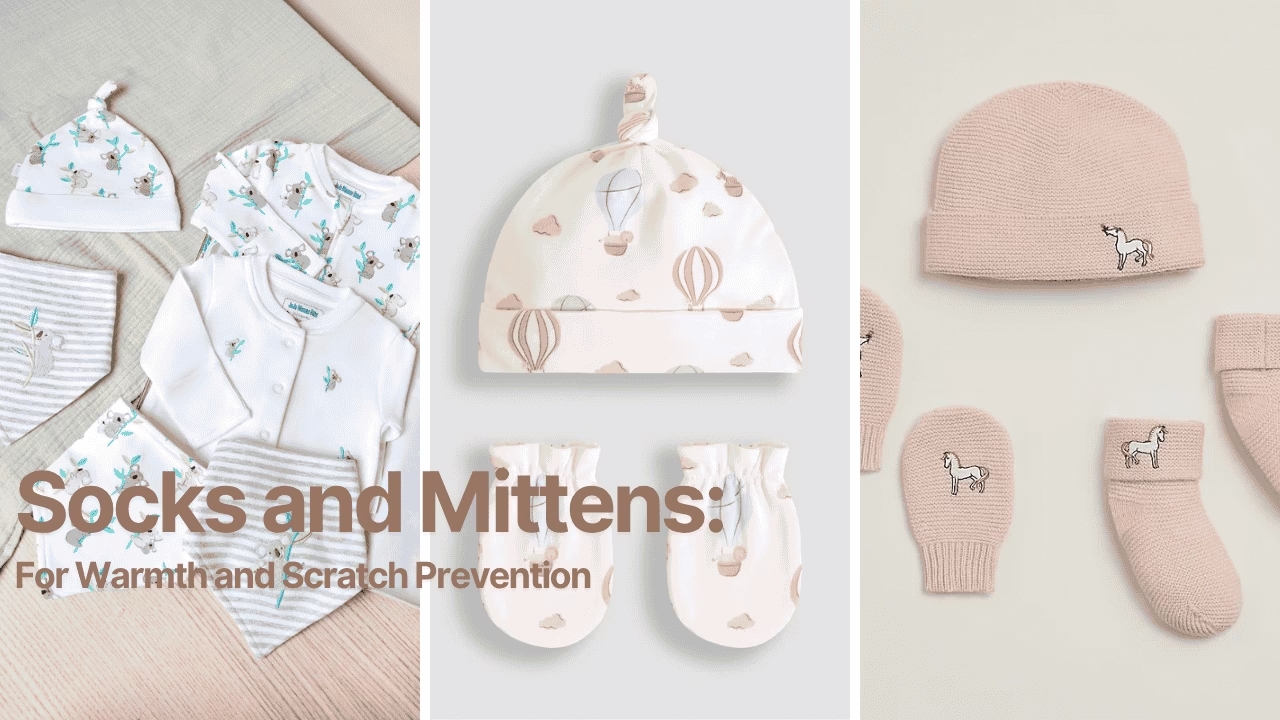
Baby Clothes Guide
| Category | Items | Description |
|---|---|---|
| Daily Wear | Onesies | The all-purpose outfit for day and night. |
| Baby Bodysuits | Layer-friendly in short and long sleeves. | |
| Leggings and Pants | Elastic waists for comfort and ease. | |
| Sleepwear | Footed Pajamas/Sleepers | Warm, easy-to-wear, and great for sleep. |
| Kimono Tops | Convenient for easy dressing and undressing. | |
| Accessories | Socks and Mittens | For warmth and scratch prevention. |

With 17 years of experience, petelulu provides a full range of
manufacturing services from design to delivery.
Start from scratch , Create your own brand.
17+
serving top 10 American brands
15+
serving top 10 Australian brands
12+
serving top 10 European brands
Contact us to get the quote.👇
Seasonal Essentials for Baby’s Comfort
Babies feel temperature changes more intensely than adults, so dressing them seasonally isn’t just about comfort—it’s about safety. Let’s walk through how to handle summer heat, winter chills, rainy days, and those unpredictable in-between seasons.
Summer Must-Haves: Breathable Rompers, Sun Hats, UV-Protective Fabrics
Summertime with a baby can be tricky. They can’t sweat efficiently, and overheating is a serious risk. Your best bet? Lightweight, breathable fabrics like organic cotton and bamboo. Rompers and onesies with short sleeves and loose fits keep things airy. Avoid synthetic fabrics like polyester, which trap heat and moisture.
One absolute essential? A good baby sun hat with a wide brim. Babies under 6 months shouldn’t wear sunscreen, so physical protection is key. Also, look for UV-protective clothing with ratings like UPF 50+—these add an extra layer of sun safety.
Other must-haves:
-
Muslin swaddles (for shade or light cover)
-
Water-friendly sandals for older babies
-
Sleeveless rompers and tank-top onesies
Stock up on 5–7 summer-friendly outfits to rotate through sweaty days and beach trips.
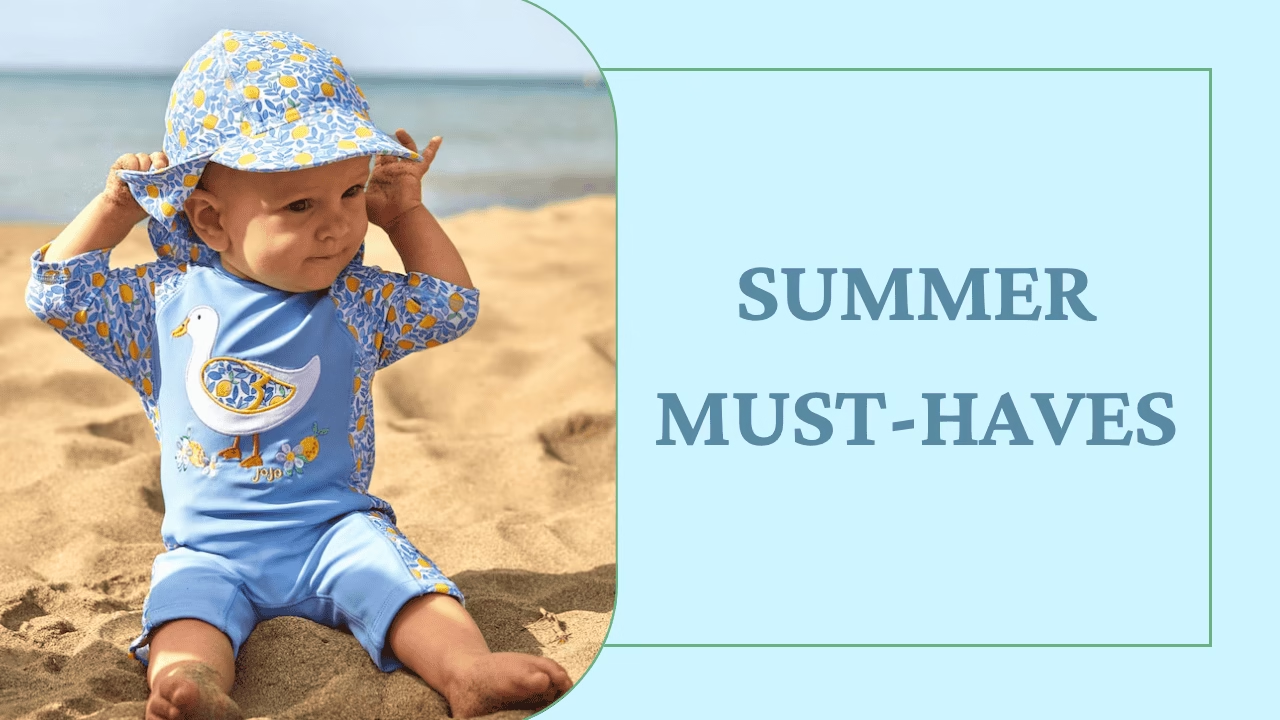
Winter Staples: Fleece Onesies, Thermal Layers, Baby Beanies, and Booties
Winter dressing is all about layering—and doing it safely. Babies should never be over-bundled, especially during sleep or in car seats. That said, keeping your baby warm when venturing outside is essential.
Start with a base layer like a bodysuit or long-sleeved onesie, then add fleece footed pajamas or thermal leggings. Soft cotton sweaters and zip-up hoodies add warmth without bulk. For outings, invest in a warm bunting suit or footmuff designed to fit strollers or car seats safely.
Accessories are just as important:
-
Fleece-lined hats or beanies
-
Knit booties or thermal socks
-
Scratch-free mittens
You’ll want 5–6 thermal outfits and a couple of outerwear pieces. Don’t forget: car seat safety requires thin layers only, so use blankets after your baby is buckled in.
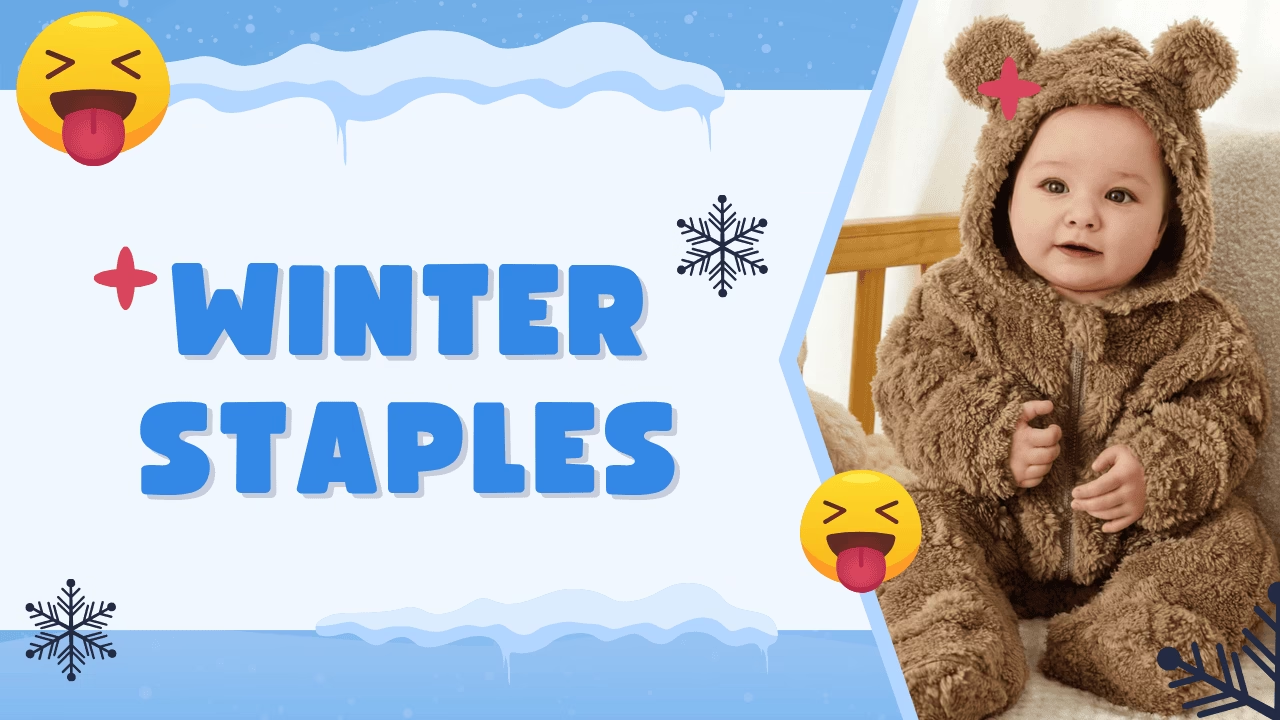
Rainy-Day Gear: Lightweight Jackets, Waterproof Pants, and Stroller Covers
Rainy days don’t stop life—especially if you have appointments or errands. Dressing your baby for wet weather is more about protecting them during transitions, like from the car to indoors or out in the stroller.
Start with a cotton base (bodysuit or onesie), then layer with a lightweight, water-resistant jacket. Waterproof pants or all-in-one suits are perfect for bigger babies who love puddles. Make sure everything is breathable so your baby doesn’t get clammy inside.
Other rainy-day essentials:
-
Waterproof stroller cover
-
Hat with a visor
-
Non-slip socks or shoes (for walkers)
You may not need more than 2–3 waterproof outfits, but a quality stroller cover is a year-round investment worth making.
Transition Weather Tips: Layering with Vests and Cotton Cardigans
Spring and fall can be wildly unpredictable—sunny in the morning, chilly by evening. That’s where layering comes in. Cotton cardigans, zip-up hoodies, and quilted vests are your best friends.
Use a short-sleeve bodysuit as a base, and layer up or down depending on the temperature. For outdoor play, add soft leggings and a light beanie. Indoors, simply remove outer layers to avoid overheating.
Great transitional items include:
-
Reversible vests
-
Stretchy cotton beanies
-
Fingerless mittens for bigger babies
Keep about 4–6 transitional pieces in the mix, and you’ll be ready for anything spring or autumn throws your way.

With 17 years of experience, petelulu provides a full range of
manufacturing services from design to delivery.
Start from scratch , Create your own brand.
17+
serving top 10 American brands
15+
serving top 10 Australian brands
12+
serving top 10 European brands
Contact us to get the quote.👇
Tips for Building a Practical Baby Wardrobe
How Many of Each Item Do You Really Need?
When building your baby’s wardrobe, it’s easy to get overwhelmed by the sheer number of clothing items available. The key to a practical wardrobe is to focus on versatility and longevity. Here’s a rough guide to how many items you’ll likely need:
-
Onesies and Bodysuits: Aim for 7-10 onesies in varying sleeve lengths (short, long, and long-sleeve for layering). This will cover your baby’s daily needs, and they’re easy to wash and rotate.
-
Sleepers and Footed Pajamas: Around 4-6 sleepers will suffice, especially if you’re doing laundry frequently. You want enough to last through several days of wear without rushing to do laundry every night.
-
Leggings and Pants: About 4-6 pairs of leggings or elastic-waist pants should be enough, depending on how often you do laundry.
-
Socks and Mittens: 4-6 pairs of socks and 2-3 pairs of mittens are usually sufficient. You don’t need a massive collection, as socks tend to get lost easily, so having a few pairs that match multiple outfits will work well.
-
Outerwear (depending on the season): 1-2 jackets or coats for winter, and a light cardigan or vest for transitional weather. You’ll also want a sun hat for summer.
Keep in mind that babies grow fast, so be sure to buy a size or two ahead for seasonal changes. Also, resist the urge to buy too much at once—start with the essentials and then gradually add pieces as your baby’s needs change.
Tips for Building a Practical Baby Wardrobe
Here’s a guide on how many items you’ll likely need for your baby’s wardrobe, categorized for ease of understanding:
| Clothing Item | Recommended Quantity | Additional Notes |
|---|---|---|
| Onesies and Bodysuits | 7-10 | Varied sleeve lengths (short, long, and long-sleeve for layering). |
| Sleepers and Footed Pajamas | 4-6 | Enough for several days of wear, especially if you do laundry frequently. |
| Leggings and Pants | 4-6 | Elastic-waist pants or leggings depending on laundry frequency. |
| Socks and Mittens | Socks: 4-6 pairs, Mittens: 2-3 pairs | Keep a few matching pairs, as socks tend to get lost easily. |
| Outerwear | 1-2 jackets/coats (winter), 1 light cardigan/vest (transitional weather) | Include a sun hat for summer. |
Choosing Sizes Based on Growth Spurts
Babies grow rapidly, so it’s important to buy clothes that accommodate growth spurts. Instead of buying all of your baby’s clothes in one size, consider purchasing a range of sizes for the next few months. For example, buy a few newborn-sized outfits, a bunch of 3-6 months, and some 6-9 months clothes. This approach ensures that you’re not left with a closet full of clothes your baby has outgrown by the time they’re ready to wear them.
When selecting sizes, it’s a good idea to use your baby’s weight as a guide. Baby clothes often have weight guidelines on the tags, which can help you gauge whether you should buy a larger size in anticipation of their growth. Also, remember that sizing can vary from brand to brand, so it’s a good idea to go with the one that seems to fit your baby best, rather than blindly following size charts.
Prioritizing Comfort, Ease of Changing, and Machine-Washable Materials
Comfort should always come first when choosing baby clothes. Look for fabrics that are gentle on your baby’s sensitive skin—organic cotton, bamboo, or cotton blends are all excellent choices. These fabrics are breathable, soft, and durable enough to handle frequent washes.
Ease of changing is another factor to consider. Baby clothes with snaps or zippers make diaper changes a lot easier than ones with buttons or intricate fastenings. As any parent will tell you, ease of access makes those late-night changes a little less frustrating. Always opt for machine-washable materials, as your baby’s clothes will likely get dirty several times a day, and the last thing you want is to be hand-washing delicate fabrics.
Buying Second-Hand or Going Minimal: Is a Capsule Baby Wardrobe Possible?
New parents are often bombarded with well-meaning advice to buy everything in sight for their baby. But the reality is that babies don’t need nearly as many clothes as people think. In fact, many parents find success in adopting a minimalist, capsule wardrobe approach for their babies.
A capsule wardrobe consists of a few key, versatile pieces that can be mixed and matched. For example, you might invest in 7-10 quality pieces of clothing that can be paired together in various combinations to create different outfits. These might include a few onesies, footed sleepers, leggings, cardigans, and a coat. This approach not only saves money but also ensures you’re not overwhelmed by clutter.
Additionally, consider buying second-hand clothing, which is a great way to save money and reduce waste. Thrift stores, online marketplaces, and baby clothing swaps are excellent places to find gently used, high-quality items. Plus, babies grow so quickly that most clothes are hardly worn, making second-hand shopping a smart, sustainable choice.

With 17 years of experience, petelulu provides a full range of
manufacturing services from design to delivery.
Start from scratch , Create your own brand.
17+
serving top 10 American brands
15+
serving top 10 Australian brands
12+
serving top 10 European brands
Contact us to get the quote.👇
Conclusion
Babies may be small, but their wardrobes seem to take up a lot of space! The trick to managing all those clothes is to focus on what’s truly necessary—comfortable, practical, and seasonally appropriate outfits that will be worn often. Basics like onesies, sleepers, and bodysuits will become your best friend, while special occasion outfits can be sprinkled in for fun.
As you shop for your baby’s clothes, remember that comfort and ease should always come first. By following the tips and guidelines in this article, you’ll create a well-rounded wardrobe that not only suits your baby’s needs but also your lifestyle. Keep in mind that babies grow quickly, so invest in clothing that is both functional and versatile, and don’t get too caught up in buying every trendy item on the market.
The goal is to save yourself time and energy—because, let’s face it, new parents have enough to juggle without spending hours deciding what to dress their baby in! So, go ahead and embrace the adorable onesies and cozy sleepers that will make those diaper changes easier and your life a bit more manageable. Happy dressing! 👕✨
FAQs
1. How many baby onesies do I need for a newborn?
It’s a good idea to have at least 7-10 onesies in your baby’s size to rotate through the week. Babies go through several changes a day, and onesies are great for quick and easy dressing.
2. What type of clothing is best for a newborn’s sensitive skin?
Organic cotton and bamboo fabrics are gentle on newborn skin. Avoid harsh synthetic materials, as they can cause irritation or discomfort.
3. When should I start buying clothes for my baby?
You can start shopping once you’re past the first trimester, but it’s best to wait until you know the baby’s sex (if you’re finding out) to avoid purchasing too many clothes in one gender. Also, consider buying clothes in a variety of sizes to accommodate rapid growth.
4. Are baby clothes with zippers better than ones with snaps?
Yes! Zippers make dressing and diaper changes easier, especially during the night. They allow for quicker access and are less likely to irritate your baby compared to multiple snaps.
5. Can I buy second-hand clothes for my baby?
Absolutely! Babies grow so quickly that many second-hand clothes are barely worn. Second-hand shopping is not only cost-effective but also environmentally friendly. Just make sure to check the quality of the items before purchasing.
About the author
Xhiney, founder of Petelulu, brings over 20 years of experience in children’s wear design, production, and international trade. A contributor to Children’s Wear and Junior magazines, Xhiney has spent 17 years working with high-end children’s wear brands in Europe and the U.S., offering expert insights and support.
